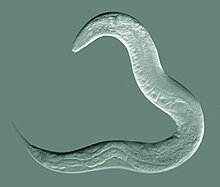| Nematode | |
|---|---|
 | |
| Caenorhabditis elegans, a model species of roundworm | |
| Scientific classification | |
| Kingdom: | Animalia |
| Subkingdom: | Eumetazoa |
| Clade: | ParaHoxozoa |
| Clade: | Bilateria |
| Clade: | Nephrozoa |
| (unranked): | Protostomia |
| Superphylum: | Ecdysozoa |
| Clade: | Nematoida |
| Phylum: | Nematoda Diesing, 1861 |
| Classes | |
(see text) | |
| Synonyms | |
| |
The nematodes (/ˈnɛmətoʊdz/ NEM-ə-tohdz or /ˈniːm-/ NEEM- Greek: Νηματώδη; Latin: Nematoda) or roundworms constitute the phylum Nematoda (also called Nemathelminthes),[2][3] with plant-parasitic nematodes also known as eelworms.[4] They are a diverse animal phylum inhabiting a broad range of environments. Taxonomically, they are classified along with insects and other moulting animals in the clade Ecdysozoa, and unlike flatworms, have tubular digestive systems with openings at both ends. Like tardigrades they have a reduced number of Hox genes, but as their sister phylum Nematomorpha has kept the ancestral protostome Hox genotype, it shows that the reduction has occurred within the nematode phylum.[5]
Nematode species can be difficult to distinguish from one another. Consequently, estimates of the number of nematode species described to date vary by author and may change rapidly over time. A 2013 survey of animal biodiversity published in the mega journal Zootaxa puts this figure at over 25,000.[6][7] Estimates of the total number of extant species are subject to even greater variation. A widely referenced[8] article published in 1993 estimated there may be over 1 million species of nematode.[9] A subsequent publication vigorously challenged this claim on the grounds that it is unsupported by fact, estimating the figure to be as low as 40,000 species.[10] Although the highest estimates (up to 100 million species) have since been deprecated, estimates supported by rarefaction curves,[11][12] together with the use of DNA barcoding[13] and the increasing acknowledgment of widespread cryptic species among nematodes,[14] have placed the figure closer to 1 million species.[15]
Nematodes have successfully adapted to nearly every ecosystem: from marine (salt) to fresh water, soils, from the polar regions to the tropics, as well as the highest to the lowest of elevations (including mountains). They are ubiquitous in freshwater, marine, and terrestrial environments, where they often outnumber other animals in both individual and species counts, and are found in locations as diverse as mountains, deserts, and oceanic trenches. They are found in every part of the earth's lithosphere,[16] even at great depths, 0.9–3.6 km (3,000–12,000 ft) below the surface of the Earth in gold mines in South Africa.[17][18][19][20][21] They represent 90% of all animals on the ocean floor.[22] In total, 4.4 × 1020 nematodes inhabit the Earth's topsoil, or approximately 60 billion for each human, with the highest densities observed in tundra and boreal forests.[23] Their numerical dominance, often exceeding a million individuals per square meter and accounting for about 80% of all individual animals on earth, their diversity of lifecycles, and their presence at various trophic levels point to an important role in many ecosystems.[23][24] They have been shown to play crucial roles in polar ecosystems.[25][26] The roughly 2,271 genera are placed in 256 families.[27] The many parasitic forms include pathogens in most plants and animals. A third of the genera occur as parasites of vertebrates; about 35 nematode species occur in humans.[27]
Nathan Cobb, a nematologist, described the ubiquity of nematodes on Earth as thus:
The term is from Greek νηματώδης (plural νηματώδεις), ntr. νηματῶδες (plural νηματώδη);[29] Latin: Nematoda.
https://en.wikipedia.org/wiki/Nematode
No comments:
Post a Comment